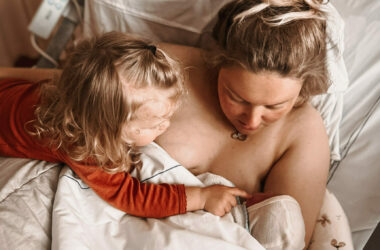Baby poop: what’s normal and what’s not
Every parent does it, taking a quick look in their baby’s diaper. And every parent also sometimes wonders if their baby’s poop is normal. In this article, you’ll read all about your baby’s poop.
Nutritionists and doctors can tell from someone’s poop if they are eating well and if they are healthy. And of course, as parents, we want to know that too. Your baby’s poop says something about its development and health. Therefore: a short lesson on “diaper reading.
Every stage of development different
Till the time your baby gets his nutrition mainly from “solid” foods, the diaper contents look different in each phase. During the first year, you will notice that color, smell, and consistency change a lot. With your newborn, you may be shocked by the green drab-like poop (meconium, made by swallowing amniotic fluid, which is very good and healthy for the baby), but a year later you may be shocked by the stench your little one can produce.
Discover and stimulate your baby's mental development
Download nowBy regularly discovering your baby’s diaper contents, you will naturally see what is normal for your baby at the stage he/she is in. More importantly, you’ll see if it deviates. If the poop is different once, it doesn’t have to be a bad thing but, it is a signal that you need to pay attention.
How often does your baby poop?
People often look at, and even write down, how often a baby poops. But actually, you can’t draw many conclusions about frequency. For example, it also depends on whether your baby is breastfed or bottle-fed. This affects the number of poop diapers and the consistency, and color of the poop. A breastfed baby who is not yet receiving solid food may poop four times a day, or only once every few days. Both are normal and healthy – as long as the poop is soft and comes out easily, there is nothing wrong. Babies who are bottle-fed and do not yet eat solid food often poop once a day to prevent constipation (congestion in the intestines).
Green dots and mustard colored
Of course, you also look at the color. And like many parents, you will sometimes wonder why there are green dots or green bits. These kinds of green dots and bits are quite normal. Again, as long as the poop is soft enough to come out easily, there is nothing wrong. In fact, it is very normal and healthy. Before your little one gets solid food, the poop is also soft (especially with breastfed babies) and sometimes looks like brightly colored mustard. Again: very normal and healthy.
Poop of a newborn
For the first few days after birth, your baby poops meconium. This is a greenish-black sticky substance created by the “eating” your baby does in the belly: tasting sips of amniotic fluid. After a few days, the intestines are filled with stool made from breastfeeding or bottle feeding and you will see less and less meconium. This will probably be after a day or two. Then you will see the poop become brownish-greenish, looser in texture, and then yellow-orange.
Poop of a baby that is bottle-fed
Breastfeeding digests more easily than bottle feeding. Therefore, a bottle-fed baby’s poop is slightly firmer than a breastfed baby and smells stronger and less pleasant. Breast milk completely digests, formula does not. Basically just like in adults: the poop contains undigested food particles. The poop looks pale yellow to yellowish brown.
Babies who are bottle-fed often poop once a day because the formula does not fully digest and thus accumulates in the intestines more quickly. When that happens, the poop gets harder and harder and it becomes increasingly difficult for your baby to empty his intestines completely. So pooping regularly and checking that the poop is not too hard is important when you bottle feed. If your little one suffers from constipation, you should see your doctor.
Poop of a baby that is breastfed
Once the meconium is flushed out of your baby’s system, out of the intestines, it gives way to the sweetish poop that comes with breast babies. No joke! Often the poop of a breastfed baby poop smells very sweet. The poop looks bright yellow to bright mustard yellow and is looser in texture with all sorts of little bits in it. With breast babies, especially in the beginning, you change a lot of diapers. Many mothers say their baby poops during or right after each feeding. You’ll find that after a few weeks to months, a rhythm will set in and your baby will poop at more regular times and less frequently.
Poop after the first bite of solid food
Once your baby starts eating solid foods, another phase of pooping begins. The phase of stinky diapers and big turds. The real thing. Of course, you don’t notice this right away. At first, the first bite is just a very small amount, really more of a taste of food than a real meal. When your little one starts eating fuller meals, you will notice a difference in the diaper as well.
And don’t forget that when you see a difference in the diaper, the intestines are therefore also doing a different job than before. Baby’s intestines have to get used to the new food as much as his taste buds have to. So during this transition phase, keep a close eye on the poop. If it gets too hard and your baby has trouble defecating, adjust the food a little.
Want to know everything about your baby’s mental development and find out how you can stimulate this? Download The Wonder Weeks app or buy the book.
Did this article help you?
Share this article
Receive a notification at the start of a leap!
Would you like to be prepared when your baby is about to enter a leap? Sign up for our leap alarm for free and always receive a notification when a leap is about to start!




